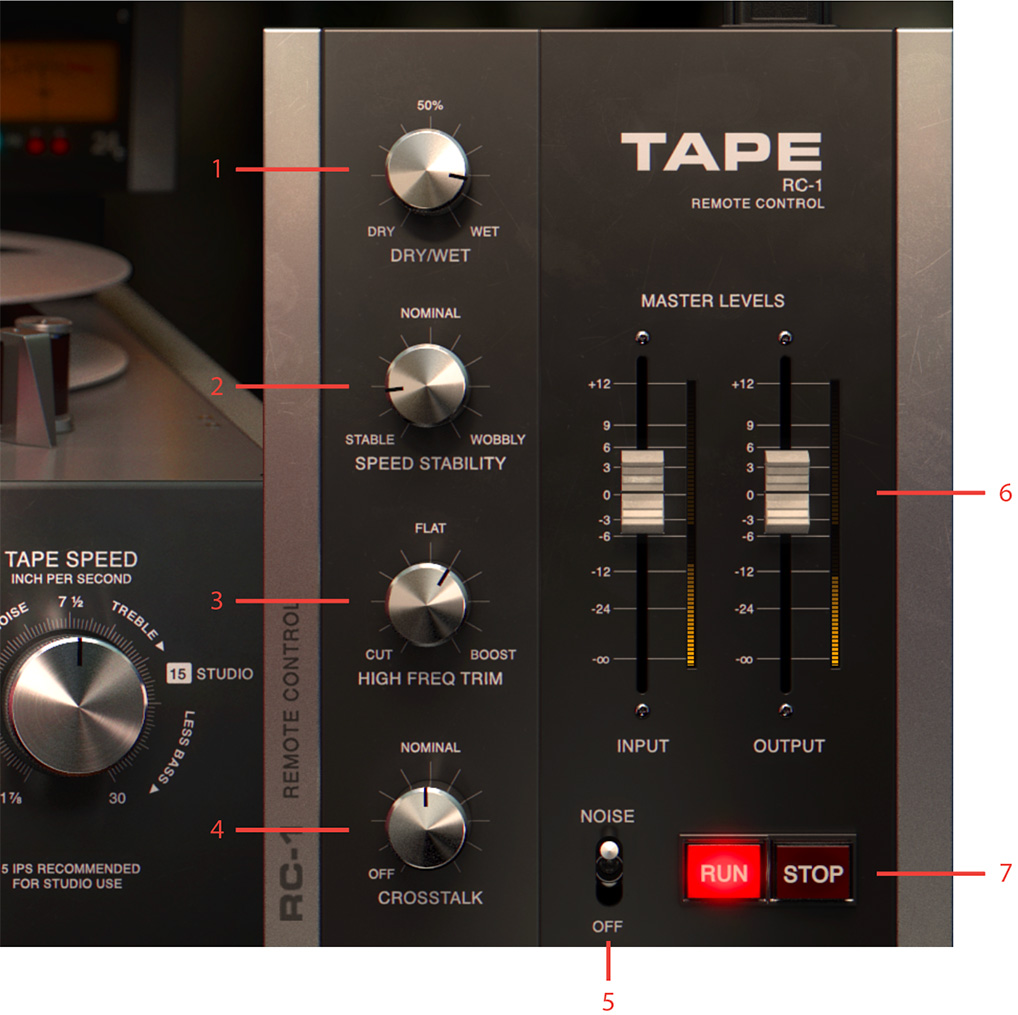After years of research, we decided to create our own tape emulation plug-in that could easily stand out among other tape emulations. We’ve modeled the characteristics of the tape machine circuits, tape head, the tape itself and took it even further in a versatile Tape plug-in, that can deliver a range of colors from subtle tape vibe to saturated warm tones. Geared with mastering grade High-Frequency Trim filter, Tape will shine on master bus and individual tracks as well.
Main View

- THD/Level meter
- VU meters
- Amount
- Type
- Tape speed
- Open side panel
Clicking the sidebar on the right side opens the panel with additional parameters.
THD/Level meter: Switches the meters between input level meter and THD (Total Harmonic Distortion) meter.
VU Meters: Show VU input level and THD amount. When in Level mode, the meters show the VU input level. Keep the input level below the red zone for subtle distortion amount. When in the red zone, the plug-in will add a larger amount of distortion and color.
When in THD mode, the meters show the distortion amount. It is handy switching to this mode to track even the most subtle distortion levels
Amount: Controls the amount of processing.
Type: Selects color types. Each color type is an essence of years of different circuits research combined to a set of iconic flavors delivering instant and rich tape vibe.
TYPE A is an emulation of Swiss tape machine that gained its popularity in the 60s.
TYPE B tape sound was inspired by a machine with a transformerbased circuit.
TYPE C was inspired by British tape machine with a distinct vintage vibe.
Tape Speed: Selects available tape speeds. 30 ips (inches per second) and 15 ips are the most neutral speed settings that will deliver mastering grade results and will work great on the master bus. Speed settings 7.5 ips and below are extremely useful for creating warm and fat tones.
Side Panel with additional controls

- Dry/Wet
- Speed stability
- High frequency trim
- Crosstalk
- Noise
- Input/Output faders and meters
- Run/Stop
Peak Meters: Show input and output levels of the plug-in. They are useful to match the input and output gains for sound comparison.
Dry/Wet: Controls the amount of dry and wet signal.
Speed Stability: Controls the amount of tape wear and tear from stable to wobbly.
Using Speed stability together with Dry/Wet may lead to chorusing sound.
High-Frequency Trim: A mastering grade filter that regulates the amount of highfrequency compensation. For the most linear frequency response set the parameter to FLAT. Increasing the amount towards BOOST will add beautiful sheen and clarity to the audio source. For vintage warm tones, move High Frequency Trim knob towards CUT.
Crosstalk: Is a model of a magnetic tape crosstalk. The parameter controls the amount of crosstalk between channels of a stereo source. When used in Studio One MIX FX mode, it controls the amount of crosstalk between the channels in the session.
See more information about Studio One Mix FX mode at http://www.presonus.com/products/Studio-One
Noise: Turns on and off tape noise.
Noise levels differ for each Tape speed.
Input: Input fader controls the input gain. Use it in conjunction with Amount knob to achieve the desired amount of color.
Output: Output fader controls the output level of the plug-in.
Run/Stop: Run and Stop buttons emulate tape speed up and speed down behavior correspondingly.
Here are a couple of tips to get started.
Getting Started
Tape Types are input dependent, so make sure to have correct gain staging, you can check the Input or THD meters for optimum levels. Insert Tape on every track or group of tracks and set the Amount until THD meter reads 1 - 1.4. If necessary, increase Input gain for more coloration.
Master Bus
To get started, choose 30 or 15 ips and adjust Amount to tame excessive transients first, then compensate high end with HF Trim. If the mix lacks punch and definition use crosstalk, it will bleed left and right channels in a way magnetic tape does. Use it to reinforce instruments in the mid (vocals, bass and kick). For most mastering applications you’ll need up to 40-50% of the crosstalk. If the vocals get too prominent, use HF Trim to tame some of the top end.
Use TYPE B if subtle coloration is needed on master bus hence TYPE B has more tolerance than TYPE A and C. You may want to use TYPE C on material lacking punch in the low end.
Electric Guitar Overload
Speed at 3 3/4 and 1 7/8 can deliver a rich harmonic tone to electric guitars. To drive electric guitar, you may need to increase the Input gain and Amount to the maximum. For warmer guitar tone, use HF Trim to tame some of the top end.
A whole range of added control can be accessed with Extended Features. Please see the separate "Extended Features" manual for more information.
Kim Larsson and Björn Rödseth – Modeling
Niklas Odelholm – Graphic design
Henrik Andersson Vogel – Marketing
Ulf Ekelöf – 3D rendering
Paul Shyrinskykh – Product management and sound design